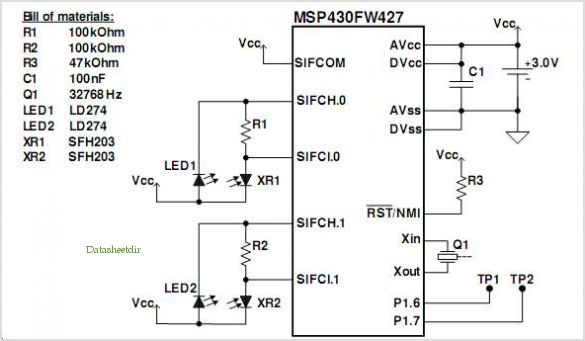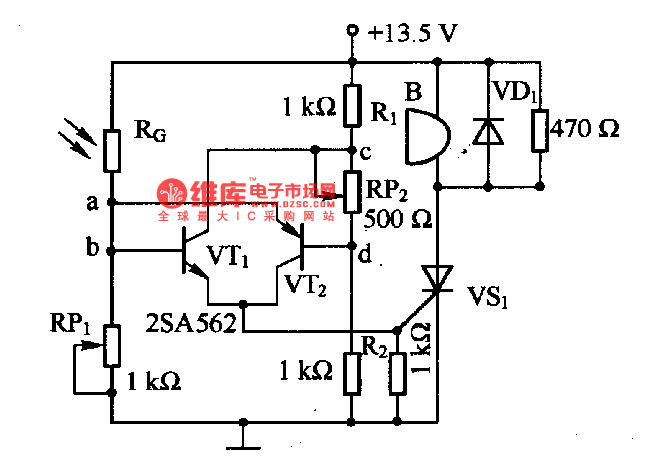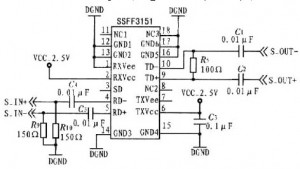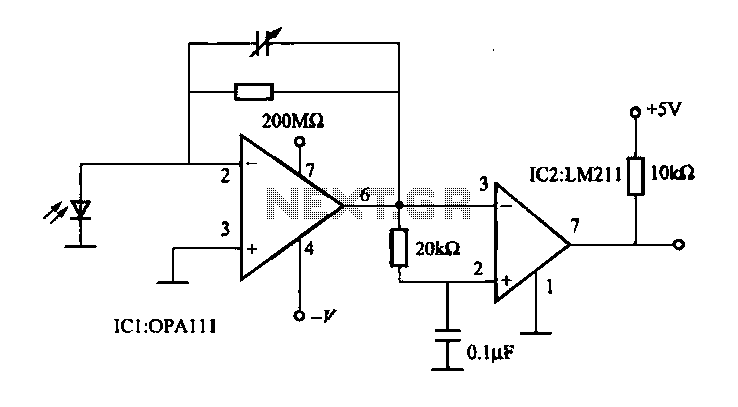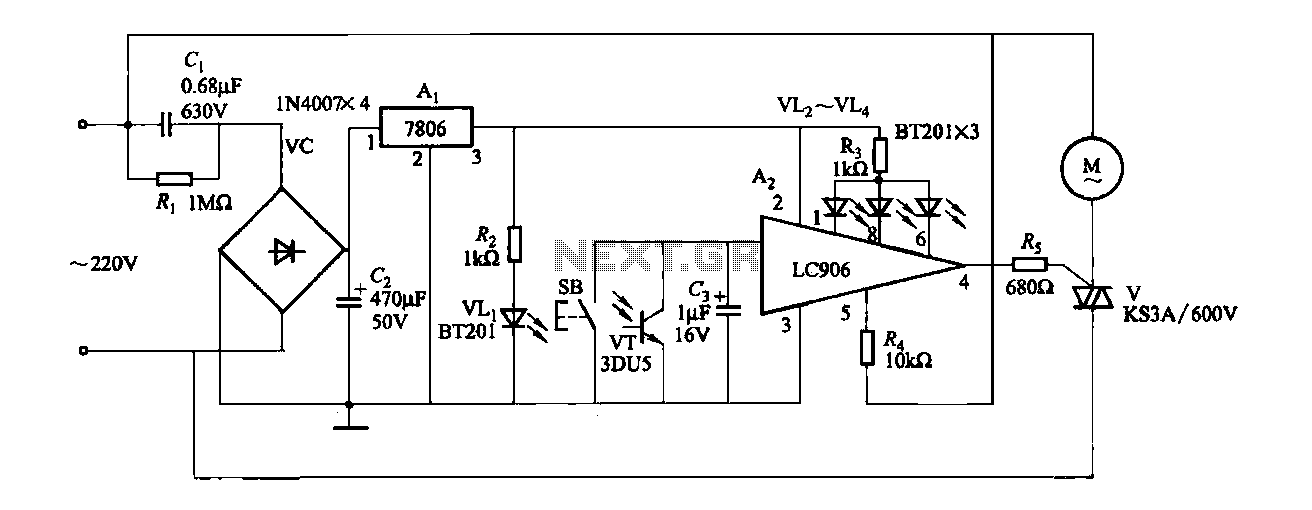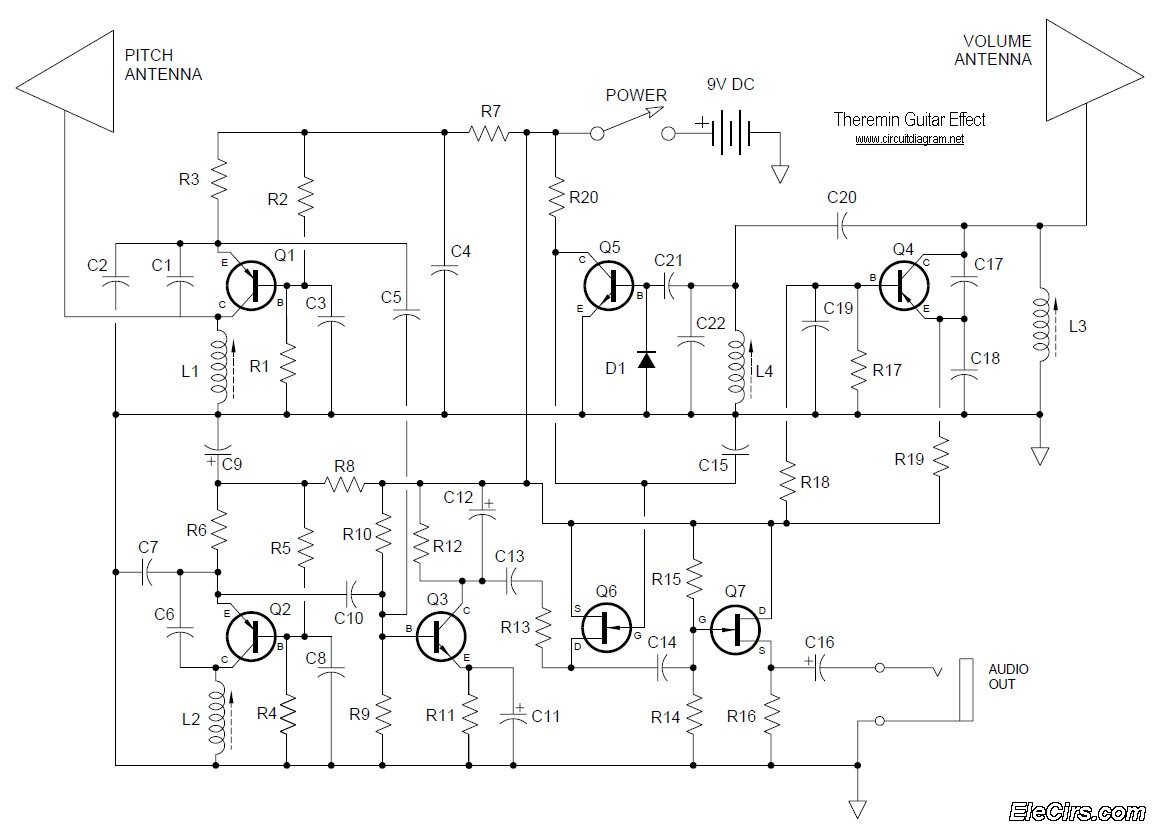
Optical Theremin
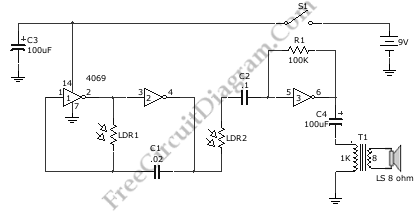
A Theremin typically operates by detecting hand proximity through the capacitive coupling method. The Theremin circuit illustrated in the schematic diagram below employs a different technique to control pitch. In this optical Theremin, the oscillator of the tone generator has both volume and frequency regulated by light-dependent resistors (LDRs), which are light-sensitive electronic components. In this configuration, LDR1 controls the frequency of the Theremin, while LDR2 manages the volume level. The LDRs can be positioned in two boxes, allowing users to manipulate the aperture of each box with their hands, thereby controlling the amount of light that reaches the LDRs. Ambient light is expected to enter the boxes through the hand-controlled apertures. This optical Theremin assumes a stable ambient light condition to facilitate smooth control. The output is delivered through a small loudspeaker, although the volume will be quite low. To achieve a higher sound level, a standard audio power amplifier can be utilized to amplify the output.
The optical Theremin circuit leverages the properties of light-dependent resistors to modulate sound frequencies and volume in response to hand movements. The LDRs are sensitive to changes in light intensity, which allows for a unique method of interaction compared to traditional Theremins that rely on capacitive sensing.
In the circuit, LDR1 is connected to a frequency oscillator, which generates audio signals at varying pitches based on the light intensity detected by the resistor. When a hand moves closer to the aperture, the amount of light reaching LDR1 increases, resulting in a lower resistance and consequently a higher frequency output. Conversely, moving the hand away reduces the light exposure, increasing the resistance and lowering the frequency.
LDR2 functions similarly, but instead of controlling frequency, it adjusts the amplitude of the output signal. This is achieved by varying the resistance in a voltage divider configuration, affecting the overall gain of the audio signal sent to the loudspeaker.
The design of the boxes containing the LDRs is crucial for achieving the desired responsiveness. The apertures should be designed to allow for smooth manipulation of light exposure while minimizing external light interference. It is beneficial to ensure that the boxes are enclosed to maintain stable ambient light conditions, thereby enhancing the performance of the optical Theremin.
The final audio output, although initially low in volume, can be connected to an audio amplifier to achieve a more pronounced sound. The use of a standard audio power amplifier allows for flexibility in sound output levels, making the optical Theremin suitable for various applications, from experimental music to educational demonstrations in electronics and sound synthesis.Normally, Thereminworks by detecting hand proximity using capacitive coupling method. A Theremin circuit shown in the schematic diagram below use different method to control the pitch. The oscillator of this tone generator, both the volume and frequency are controlled using LDRs, a light sensitive electronic component, so we can call this circuit anoptical Theremin. Look at the following schematic diagram: LDR1 control the frequency of this Theremin, while LDR2 control the volume level. We can place the LDR in two boxes where we can use our hand to control the aperture of the box, allowing smooth control of light amount that expose the LDR.
This light is expected to come from ambient light, entering the box through the hand controlled aperture. This optical Theremin assume a stable ambient light to produce smooth control. The output will be heard on a small loudspeaker, but will be in very low volume. You can just amplify this output with a standard audio power amplifier to get better loudness. 🔗 External reference
The optical Theremin circuit leverages the properties of light-dependent resistors to modulate sound frequencies and volume in response to hand movements. The LDRs are sensitive to changes in light intensity, which allows for a unique method of interaction compared to traditional Theremins that rely on capacitive sensing.
In the circuit, LDR1 is connected to a frequency oscillator, which generates audio signals at varying pitches based on the light intensity detected by the resistor. When a hand moves closer to the aperture, the amount of light reaching LDR1 increases, resulting in a lower resistance and consequently a higher frequency output. Conversely, moving the hand away reduces the light exposure, increasing the resistance and lowering the frequency.
LDR2 functions similarly, but instead of controlling frequency, it adjusts the amplitude of the output signal. This is achieved by varying the resistance in a voltage divider configuration, affecting the overall gain of the audio signal sent to the loudspeaker.
The design of the boxes containing the LDRs is crucial for achieving the desired responsiveness. The apertures should be designed to allow for smooth manipulation of light exposure while minimizing external light interference. It is beneficial to ensure that the boxes are enclosed to maintain stable ambient light conditions, thereby enhancing the performance of the optical Theremin.
The final audio output, although initially low in volume, can be connected to an audio amplifier to achieve a more pronounced sound. The use of a standard audio power amplifier allows for flexibility in sound output levels, making the optical Theremin suitable for various applications, from experimental music to educational demonstrations in electronics and sound synthesis.Normally, Thereminworks by detecting hand proximity using capacitive coupling method. A Theremin circuit shown in the schematic diagram below use different method to control the pitch. The oscillator of this tone generator, both the volume and frequency are controlled using LDRs, a light sensitive electronic component, so we can call this circuit anoptical Theremin. Look at the following schematic diagram: LDR1 control the frequency of this Theremin, while LDR2 control the volume level. We can place the LDR in two boxes where we can use our hand to control the aperture of the box, allowing smooth control of light amount that expose the LDR.
This light is expected to come from ambient light, entering the box through the hand controlled aperture. This optical Theremin assume a stable ambient light to produce smooth control. The output will be heard on a small loudspeaker, but will be in very low volume. You can just amplify this output with a standard audio power amplifier to get better loudness. 🔗 External reference
